Low Power Consumption Signal Detector Based on Adaptive DFSD in MIMO-OFDM Systems
Abstract
1. Introduction
2. System Model
3. Conventional Signal Detection Schemes
3.1. Maximum Likelihood Detection
3.2. Conventional Depth-First Sphere Decoding
4. Proposed Adaptive DFSD Detection Scheme
4.1. The Adaptive DFSD Detection Scheme According to the Number of Nodes at the -th Layer
4.2. The Thresholds Based on Channel Condition
5. Simulation Results
5.1. The Bit Error Rate Performance
5.2. The Complexity
6. Conclusions
Author Contributions
Acknowledgments
Conflicts of Interest
References
- Paulraj, A.J.; Gore, D.A.; Nabar, R.U.; Bolcskei, H. An overview of MIMO communications-a key to gigabit wireless. Proc. IEEE 2004, 92, 198–218. [Google Scholar] [CrossRef]
- Foschini, G.J. Layered space-time architecture for wireless communication in a fading environment when using multi-element antennas. Bell Labs Tech. J. 1996, 1, 41–59. [Google Scholar] [CrossRef]
- Tarokh, V.; Seshadri, N.; Calderbank, A.R. Space-time codes for high data wireless communication: performance criterion and code construction. IEEE Trans. Inf. Theory 1998, 44, 744–765. [Google Scholar] [CrossRef]
- Jiang, Y.; Varanasi, M.K.; Li, J. Performance analysis of ZF and MMSE equalizers for MIMO systems: An in-depth study of the high SNR regime. IEEE Trans. Inf. Theory 2011, 57, 2008–2026. [Google Scholar] [CrossRef]
- Shao, X.; Yuan, J.; Shao, Y. Error performance analysis of linear zero forcing and MMSE precoders for MIMO broadcast channels. IET Commun. 2007, 1, 1067–1074. [Google Scholar] [CrossRef]
- Bei, W.; Zhu, Q. A low complex V-BLAST detection algorithm for MIMO-OFDM system. In Proceedings of the 4th International Conference on Wireless Communications, Networking and Mobile Computing, Dalian, China, 11–14 October 2008. [Google Scholar]
- Golden, G.D.; Foschini, C.J.; Valenzuela, R.A.; Wolniansky, P.W. Detection algorithm and initial laboratory results using V-BLAST space-time communication architecture Electron. Lett. 1999, 35, 14–16. [Google Scholar]
- Farhoodi, A.A.; Biguesh, M. ML detection in MIMO communication systems with imperfect channel knowledge. In Proceedings of the IEEE International Symposium on Signal Processing and Information Technology, Vancouver, BC, Canada, 27–30 August 2006. [Google Scholar]
- Zhu, X.; Murch, R.D. Performance analysis of maximum likelihood detection in a MIMO antenna system. IEEE Trans. Commun. 2002, 50, 187–191. [Google Scholar] [CrossRef]
- Viterbo, E.; Boutros, J. A universal lattice code decoder for fading channels. IEEE Trans. Inf. Theory 1999, 45, 1639–1642. [Google Scholar] [CrossRef]
- Li, S.P.; Wang, L.; Chen, F.C. Ordered sphere decoding detection algorithm for MIMO systems. In Proceedings of the 24th Chinese Control and Decision Conference, Taiyuan, China, 23–25 May 2012. [Google Scholar]
- Hassibi, B.; Vikalo, H. On the sphere-decoding algorithm I. Expected complexity. IEEE Trans. Signal Process. 2005, 53, 2806–2818. [Google Scholar] [CrossRef]
- Albreem, M.A.M.; Salleh, M.F.M. Lattice sphere decoding technique assisted optimum detection for block data transmission systems. In Proceedings of the International Conference on Cyber-Enabled Distributed Computing and Knowledge Discovery, Sanya, China, 10–12 October 2012. [Google Scholar]
- Barbero, L.G.; Thompson, J.S. Fixing the complexity of the sphere decoder for MIMO detection. IEEE Trans. Wirel. Commun. 2008, 7, 2131–2142. [Google Scholar] [CrossRef]
- Jang, H.; Nooshabadi, S.; Kim, K.; Lee, H.N. Circular Sphere Decoding: A Low Complexity Detection for MIMO Systems With General Two-dimensional Signal Constellations. IEEE Trans. Veh. Technol. 2017, 66, 2085–2098. [Google Scholar] [CrossRef]
- Wen, Y.; Wu, L. A modified sphere detection algorithm with lower complexity for MIMO detection. In Proceedings of the International Conference on Communication, Control, Computing and Electronics Engineering, Khartoum, Sudan, 16–18 January 2017. [Google Scholar]
- Rachid, M.; Daneshrad, B. A low-complexity iterative MIMO sphere decoding algorithm. In Proceedings of the 17th European Signal Processing Conference, Glasgow, UK, 24–28 August 2009. [Google Scholar]
- Choi, S.J.; Kim, J.K. Lattice-reduction aided signal detection method with switching detection based on channel condition. IEICE Trans. Fundam. Electron. Commun. Comput. Sci. 2017, E100-A, 2539–2542. [Google Scholar] [CrossRef]
- Maurer, J.; Matz, G.; Seethaler, D. Low-complexity and full-diversity MIMO detection based on condition number thresholding. In Proceedings of the IEEE International Conference on Acoustics, Speech and Signal Processing, Honolulu, HI, USA, 15–20 April 2007. [Google Scholar]
- Sutar, M.B.; Patil, V.S. LS and MMSE estimation with different fading channels for OFDM system. In Proceedings of the International Conference of Electronics, Communication and Aerospace Technology, Coimbatore, India, 20–22 April 2017. [Google Scholar]
- Yoo, H.; Jeong, J.; Lee, J. Signal position-based adaptive QR decompositionbased M detection algorithm for multiple-input multiple-output systems. IET Signal Proc. 2011, 5, 598–602. [Google Scholar] [CrossRef]
- Lim, H.; Park, G.; Yoon, D. Clipping method for adaptive QRD-M detection. In Proceedings of the International Conference on Information and Communication Technology Convergence, Jeju, Korea, 18–20 October 2017. [Google Scholar]
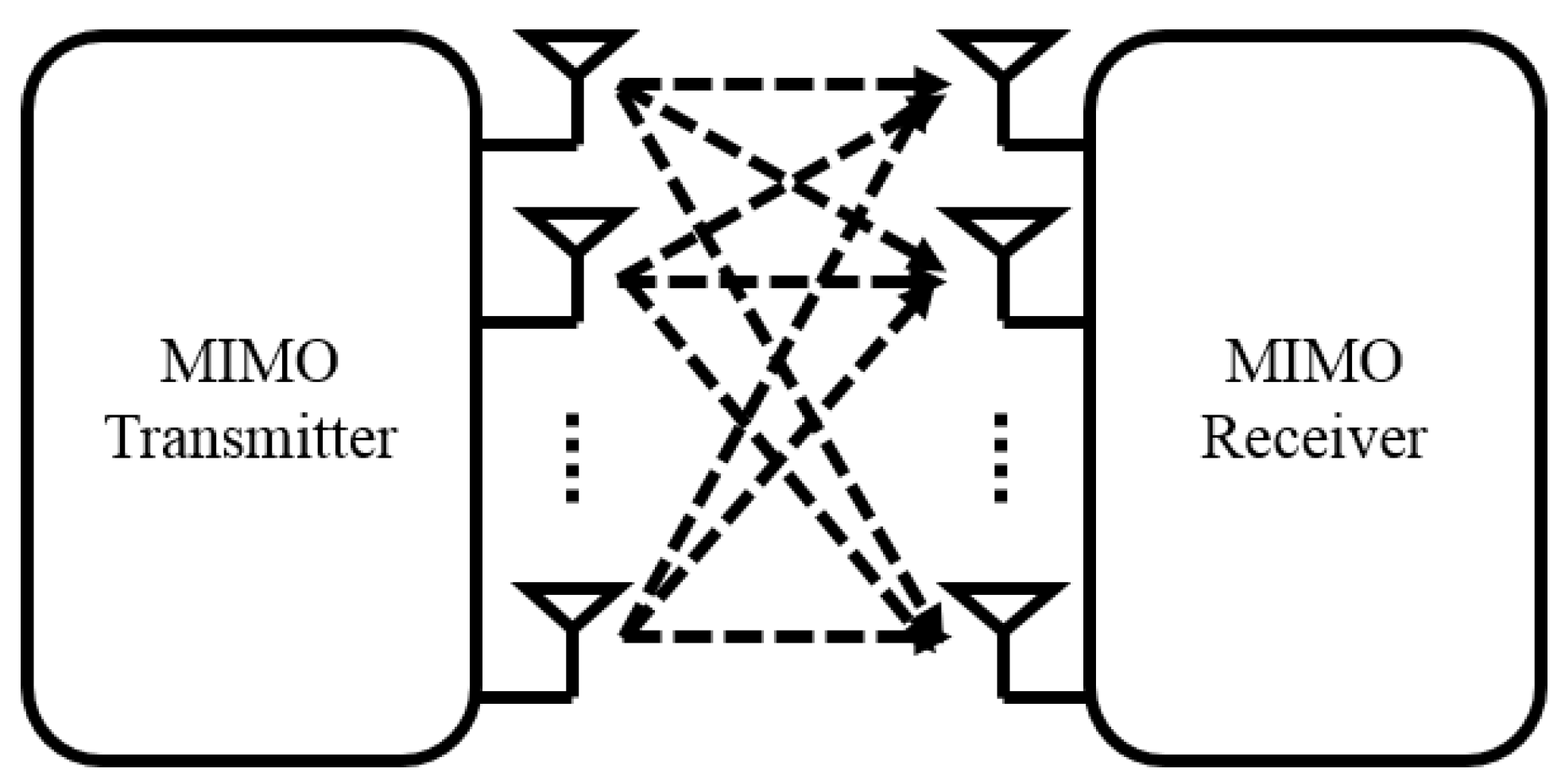

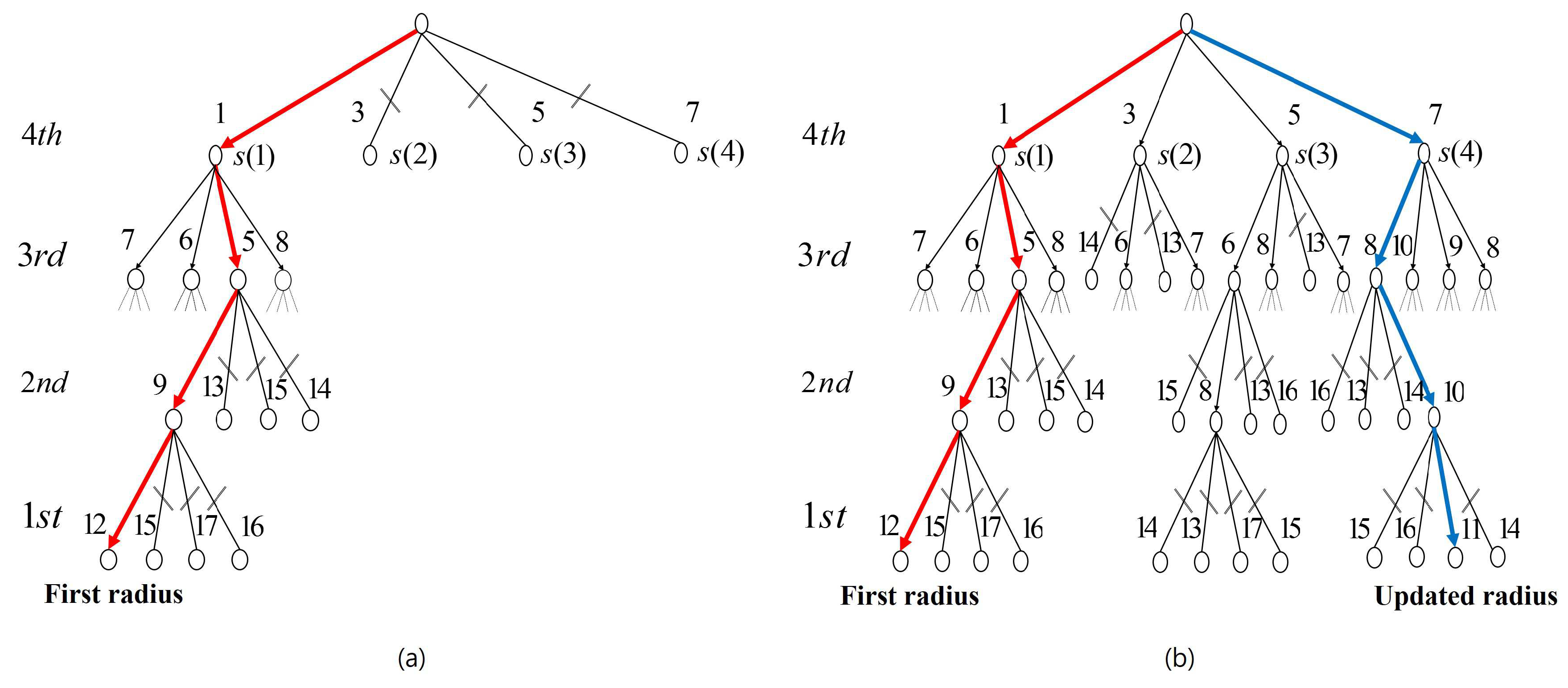

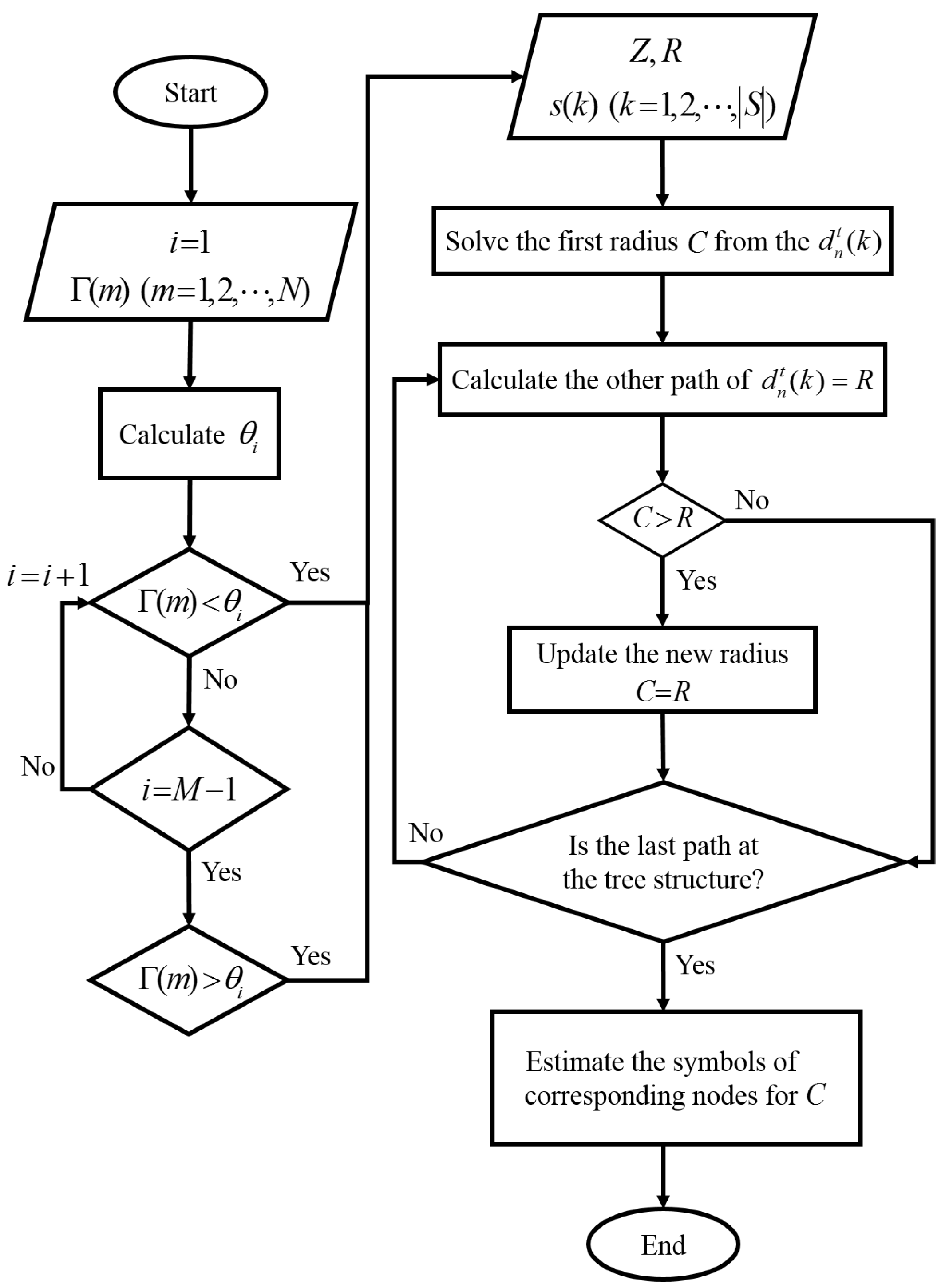
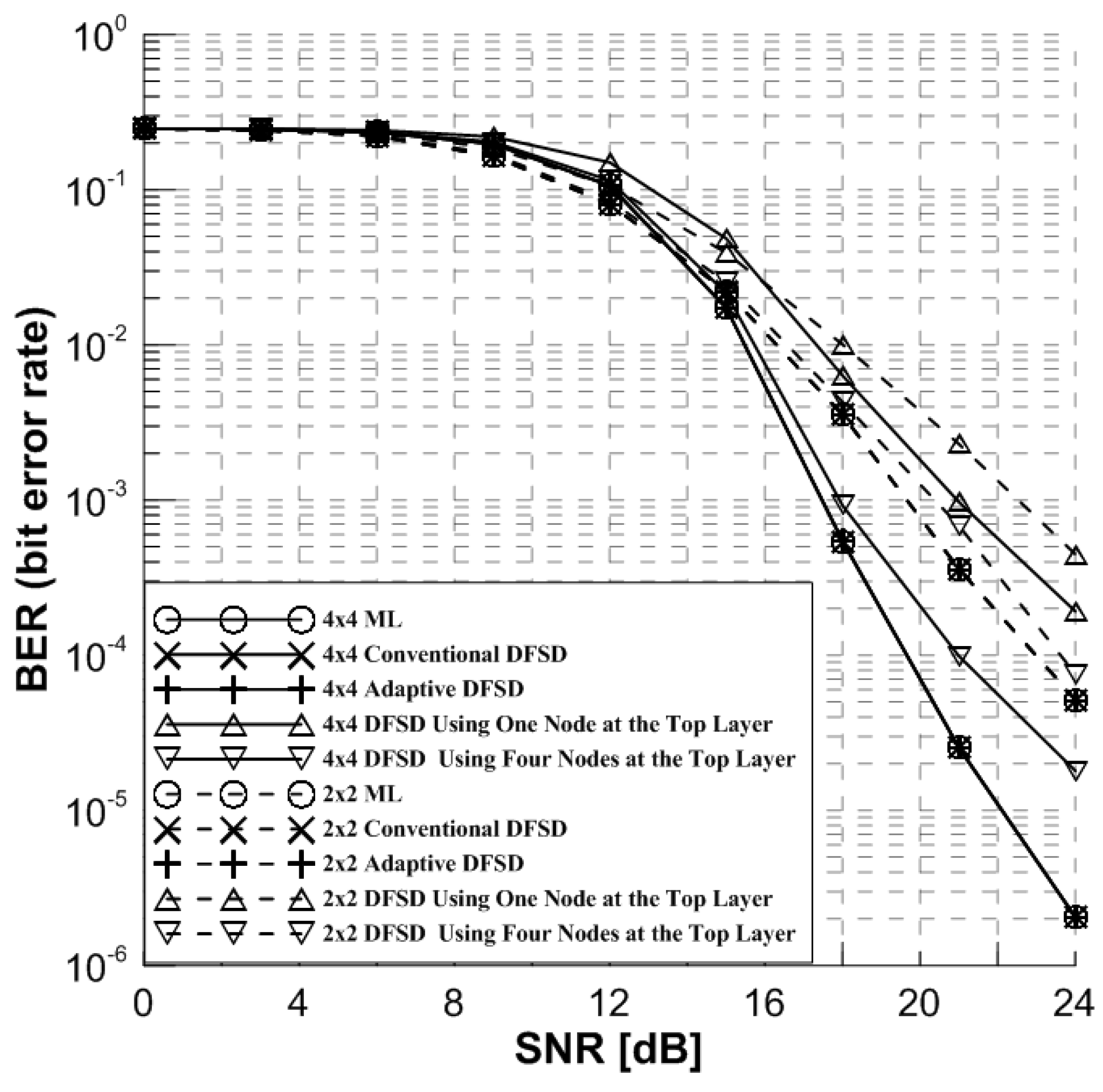
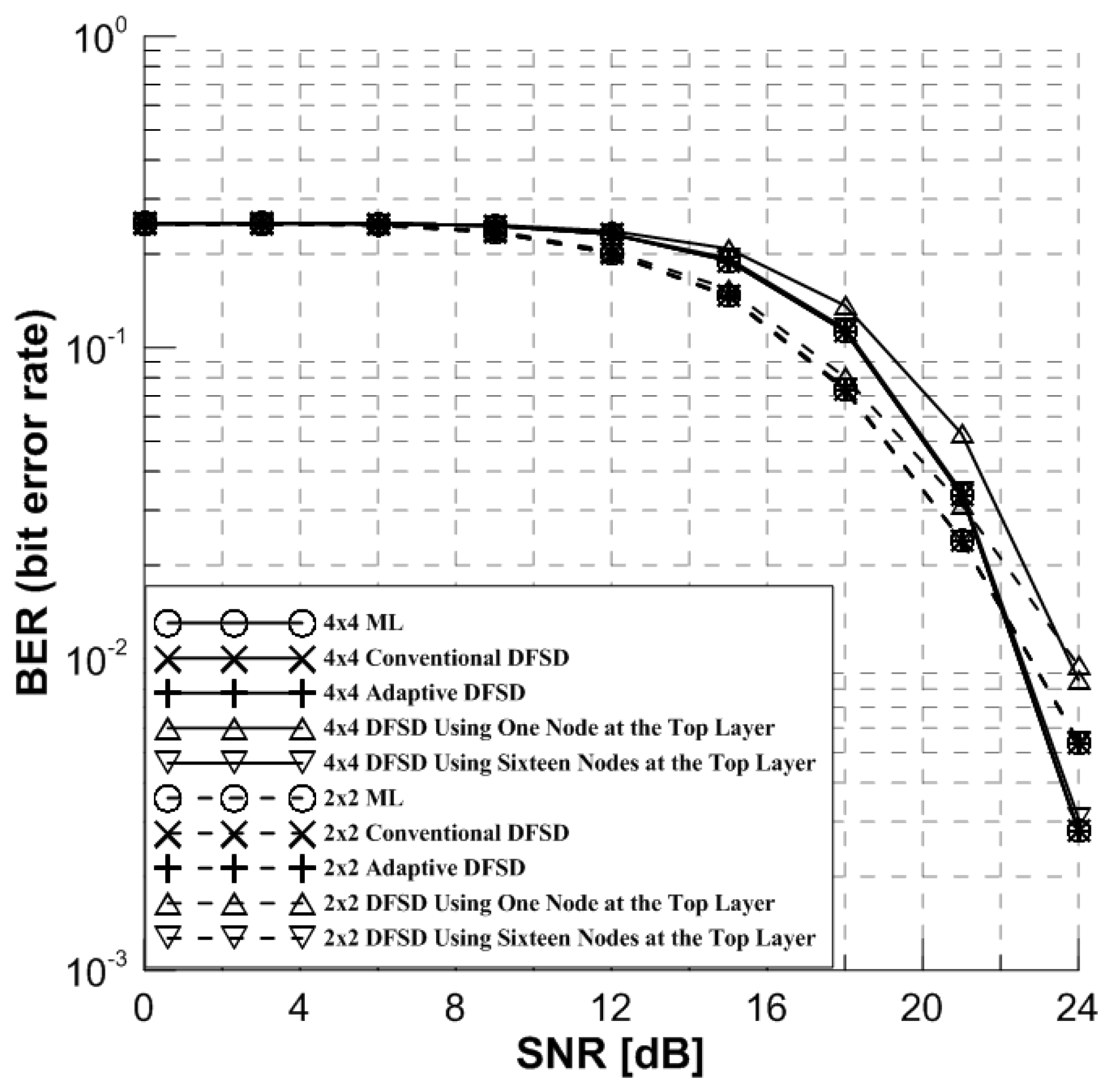
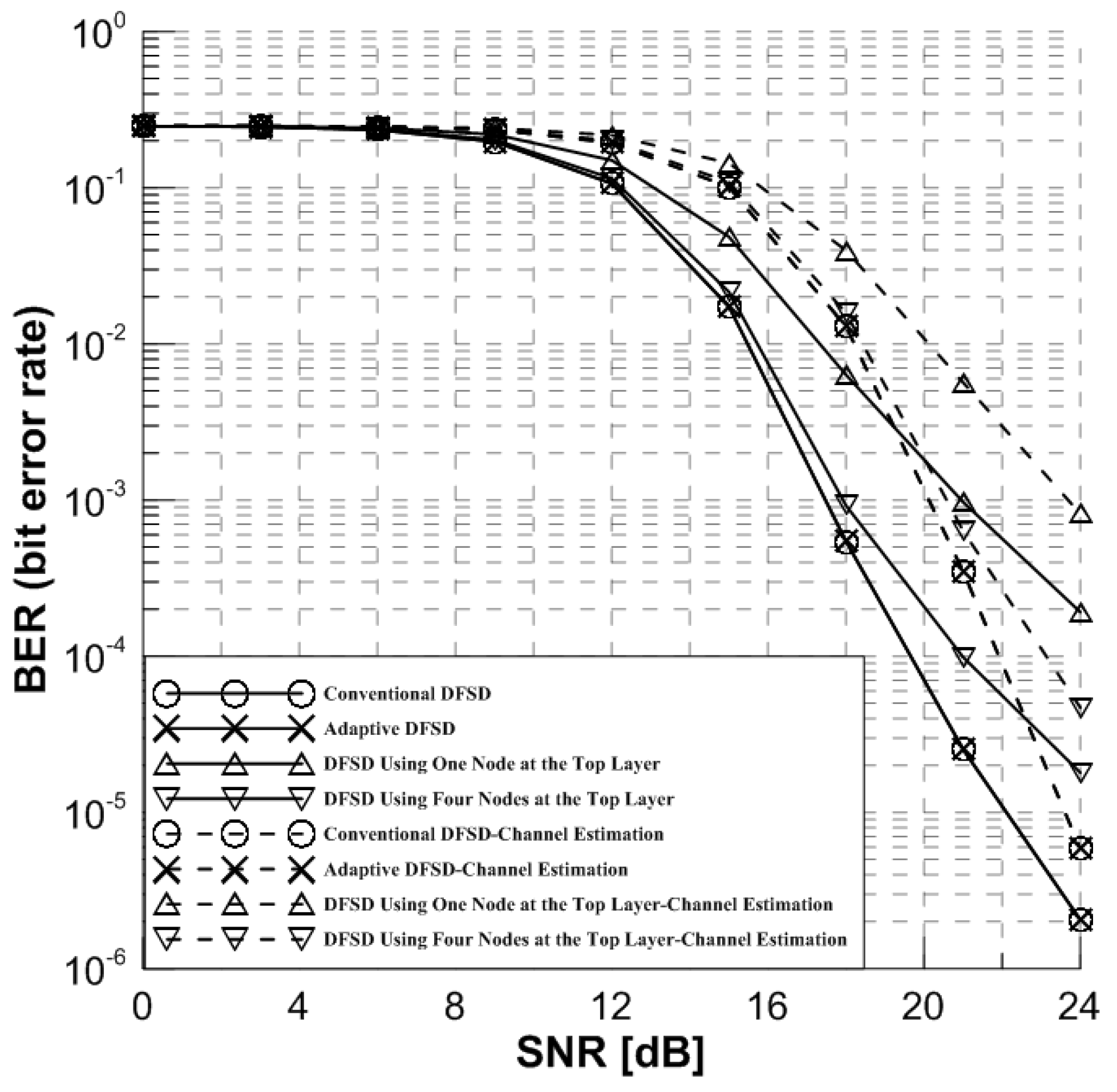
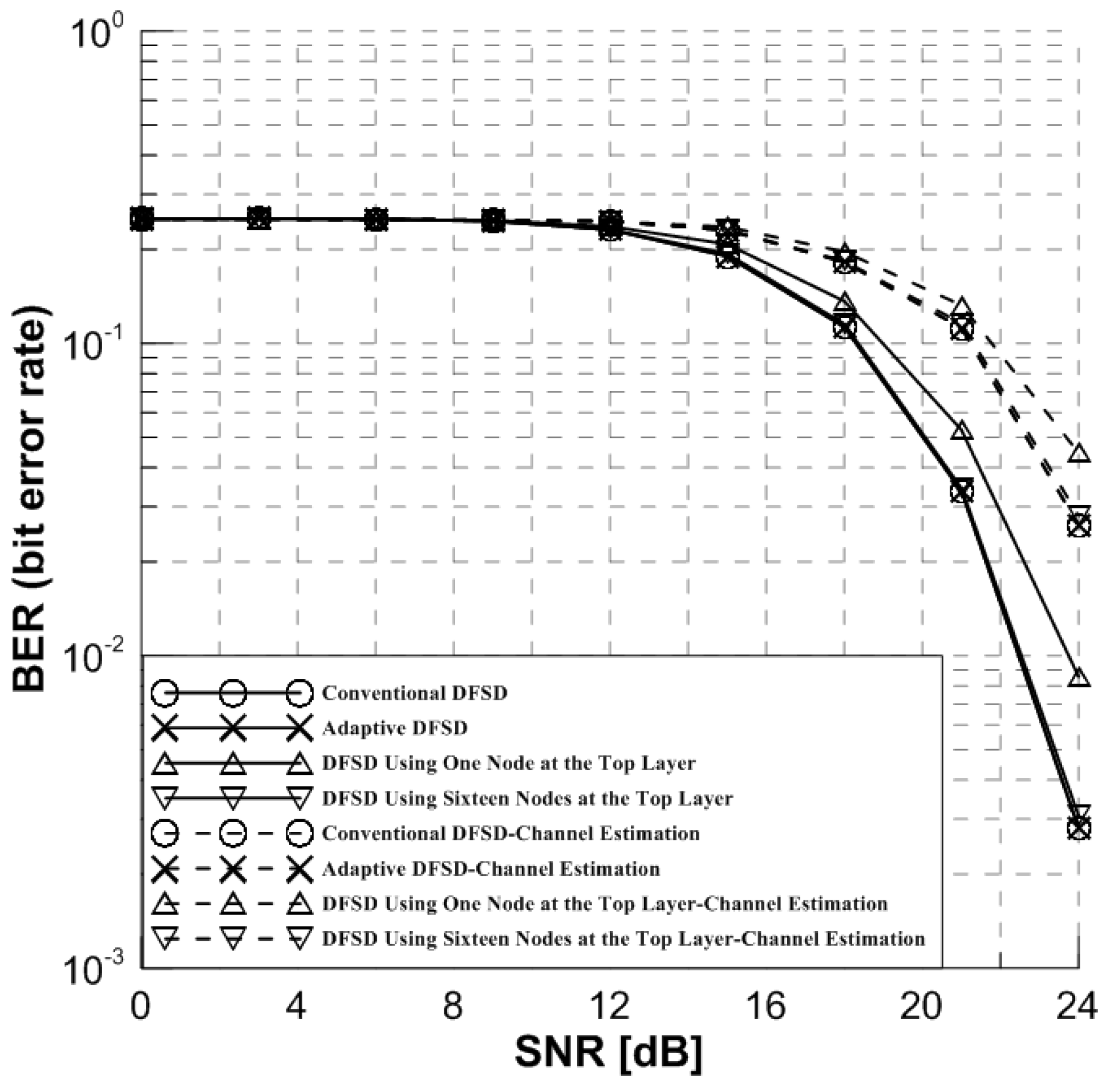
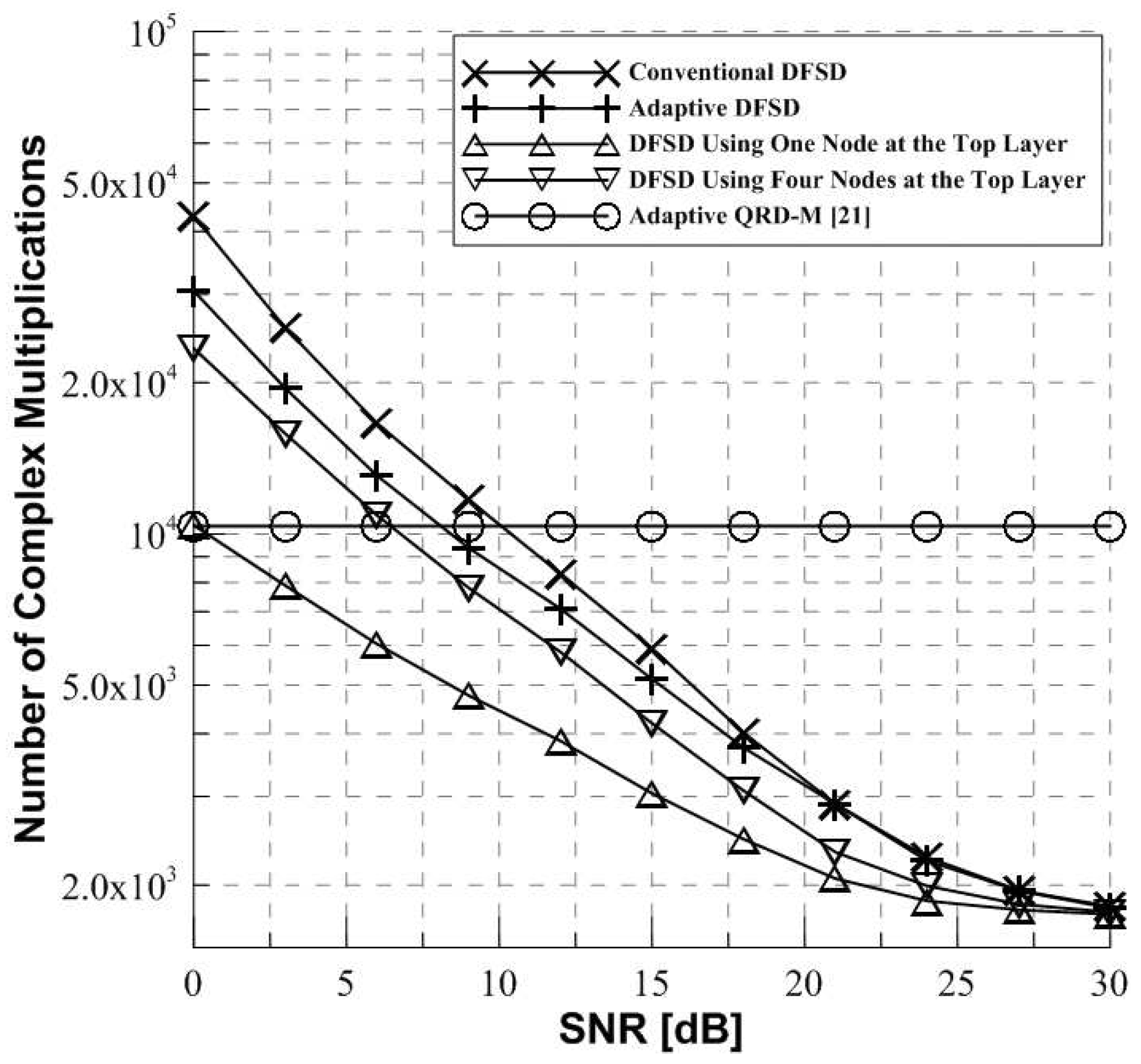
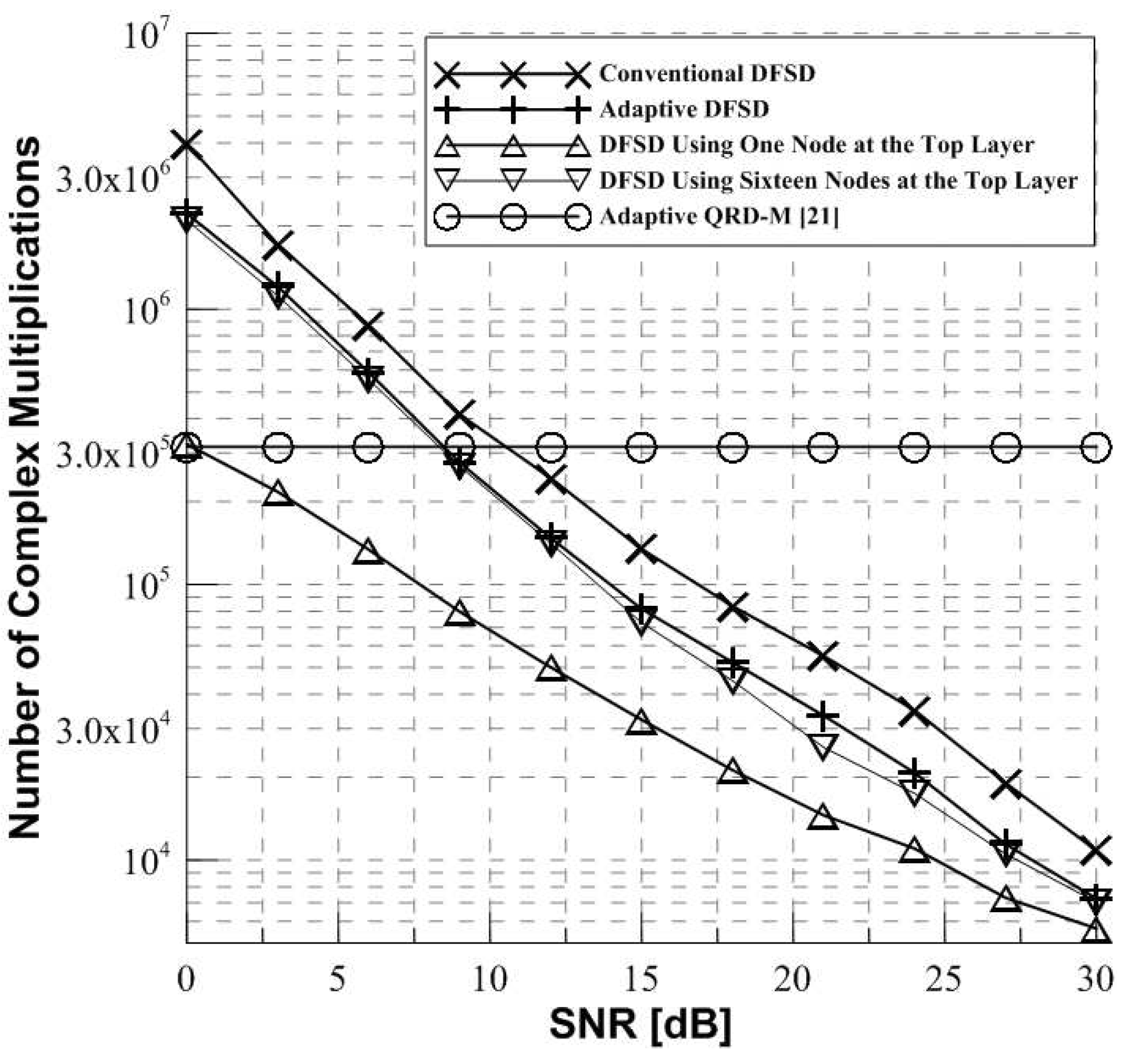
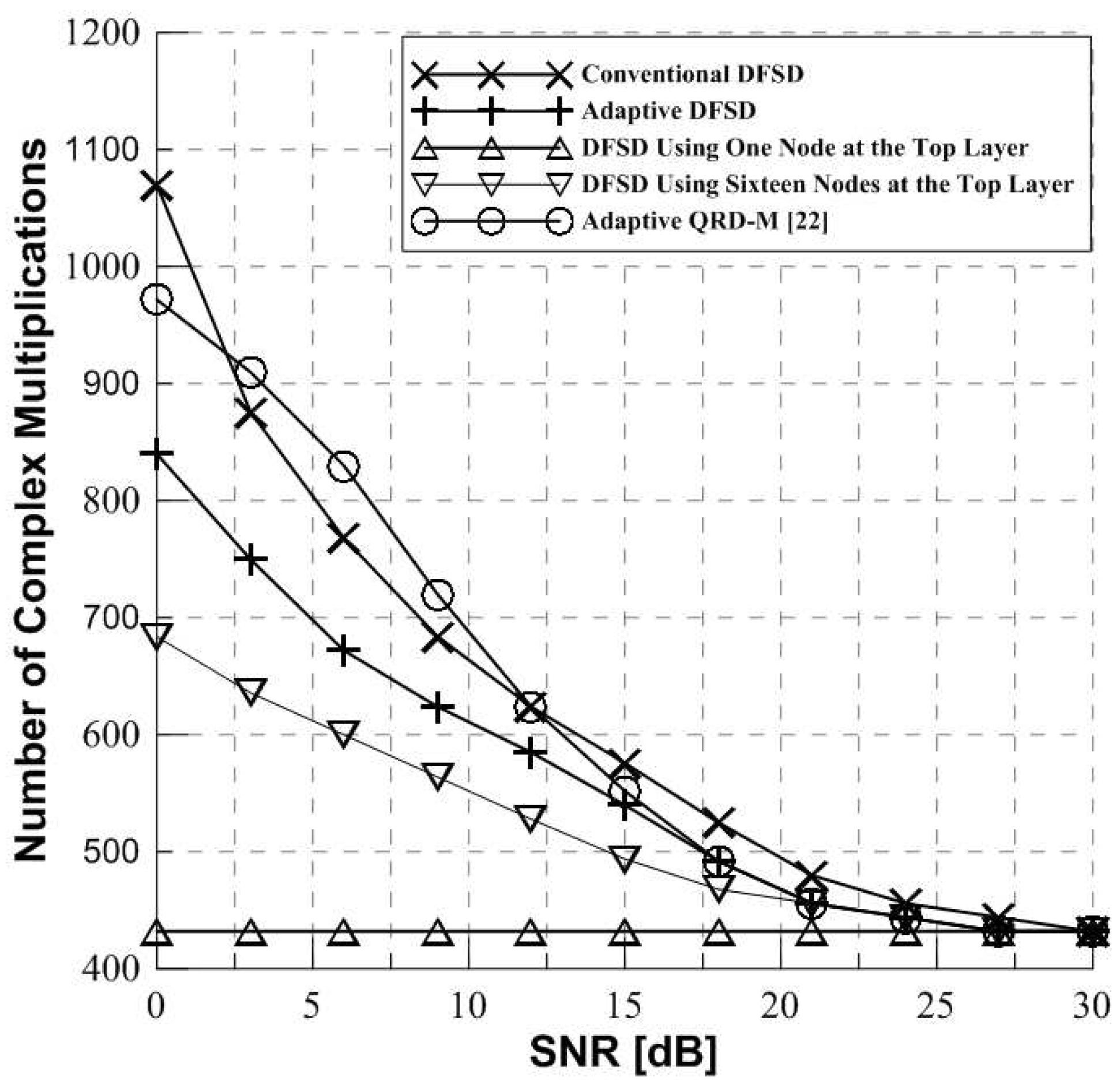
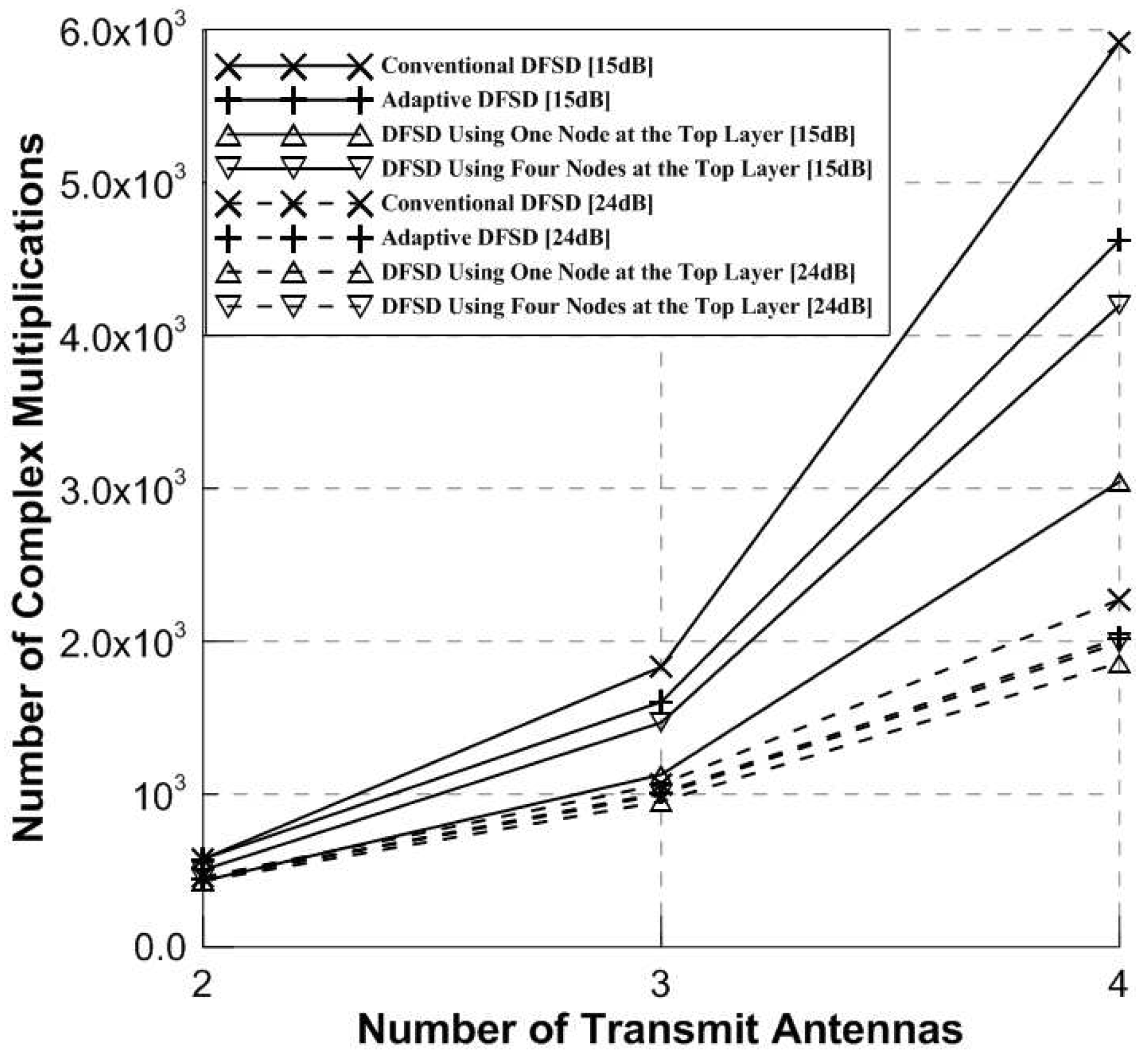
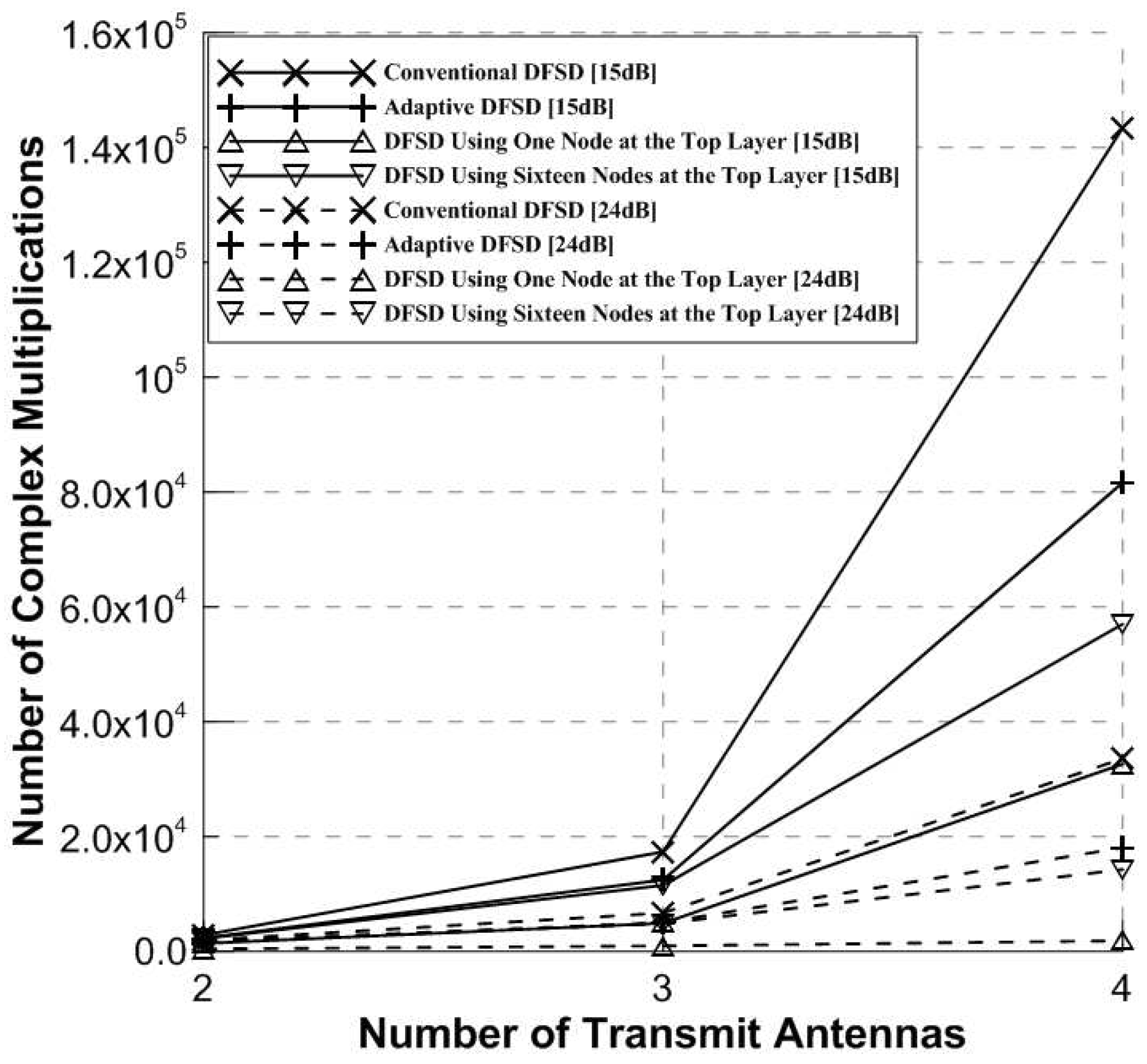
| Detection Scheme | Complex Multiplication Expression |
|---|---|
| Conventional DFSD | |
| Adaptive DFSD | |
| DFSD using n nodes at the top layer | |
| Adaptive QRD-M | |
| : the number of nodes at the i-th layer |
© 2019 by the authors. Licensee MDPI, Basel, Switzerland. This article is an open access article distributed under the terms and conditions of the Creative Commons Attribution (CC BY) license (http://creativecommons.org/licenses/by/4.0/).
Share and Cite
Shim, S.-J.; Choi, S.-J.; Song, H.-K. Low Power Consumption Signal Detector Based on Adaptive DFSD in MIMO-OFDM Systems. Energies 2019, 12, 599. https://doi.org/10.3390/en12040599
Shim S-J, Choi S-J, Song H-K. Low Power Consumption Signal Detector Based on Adaptive DFSD in MIMO-OFDM Systems. Energies. 2019; 12(4):599. https://doi.org/10.3390/en12040599
Chicago/Turabian StyleShim, Seong-Joon, Seung-Jin Choi, and Hyoung-Kyu Song. 2019. "Low Power Consumption Signal Detector Based on Adaptive DFSD in MIMO-OFDM Systems" Energies 12, no. 4: 599. https://doi.org/10.3390/en12040599
APA StyleShim, S.-J., Choi, S.-J., & Song, H.-K. (2019). Low Power Consumption Signal Detector Based on Adaptive DFSD in MIMO-OFDM Systems. Energies, 12(4), 599. https://doi.org/10.3390/en12040599





